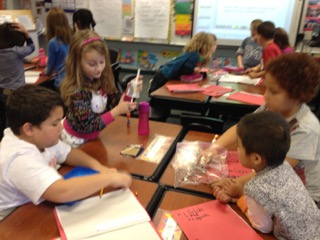Lesson 3
Making Lessons Interactive While Developing Creativity and Innovative Thinking
Learning Outcomes
Participants will become familiar with more ways to make daily lessons more interactive through the usage of digital tools and hands-on manipulatives.
Participants will explore ways to develop the creative potential and innovative thinking of their students.
Before we get started, please explore these readings.
Let's think about the subjects we teach on a daily basis-Reading, Phonics, Math, Science, Social Studies, etc. How can we use digital tools and hands-on activities to complement our teaching? Consider the following suggestions.
Phonics
Learning to read is a major focus of first grade. Most of us teach phonics to a first graders as a way to decode words. Rather than sticking with worksheets and workbooks, try these instead!
Are any of you old enough to remember the old Electric Company tv show that taught many of us how to read? (There is a newer version of the show, as well.) Many clips from this show have been preserved on YouTube. Go and search the phonics skill you are working on, and a list of videos will pop up. My first grade class loved learning phonics with these videos! Rather than remaining passive learners, sitting in their seats, they were up and moving, singing along! As primary teachers, we all know that the more senses you involve, the more likely our students are to retain the information being taught. Check out this sample video on Bossy R.
Just for fun, here's a "retro" Electric Company video on Silent e
For more phonics fun, check out these sites:
Hands-on phonics:
- write word family words in shaving cream
- use letter tiles or cubes to spell words
- stack cups with letters on them to spell words
- magnetic letters to spell words
Let kids choose an activity that works for them!
Reading
Many reading series' that are in use today come with wonderful resources for online learning, from phonics, spelling and vocabulary games, to online stories. Check yours out, if you haven't already, to see what is offered!
Additional ideas:
- have students post book reviews to the classroom blog
- share favorite story titles on Twitter
- listen to celebrities and authors read familiar picture books on StorylineOnline
- have students work together to create alternate endings to familiar stories
Be sure and allow for students to reflect on stories through a variety of modes. Consider the following:
- Reader's Theater
- Sketch-to-Sketch-after reading, students draw what they believe the central theme of the story is
- Musical or dance interpretations of stories, or story themes
- Conscience Circles-students go around the circle and take turns naming a character, and telling what advice they would give to him/her
- Create a comic strip with the characters using StoryBoardThat
- Use iFakeText to create conversations between characters
Math
Hands-on learning takes center stage in primary elementary math. We use base ten blocks, unifix cubes, play money, fraction circles, counters, and more to help our students gain a concrete understanding of math concepts. Many manipulatives can be found online for use to teach concepts on the interactive white board, or for further exploration on student computers during centers.
Many of us use math journal prompts to get kids to think critically about math to solve problems. Why not let kids video tape themselves explaining their mathematical thinking to post on the class website?
Science
In my opinion, integrating the 4 C's of 21st century learning in science is pretty easy these days. When I was a kid, we pretty much just read about science and answered endless worksheet questions. Thankfully, with the emphasis on STEM education, we now are blessed with science kits full of hands-on activities ad opportunities for kids to work collaboratively and use creativity and critical thinking. The picture above (and at the top of the page) is my first grade class working on an engineering assignment. Each group was given the same set of random, every day objects. The challenge was to see which group could build the tallest tower. Of course, we used our science journals to draw, write, label, and make and confirm predictions.
Consider the following resources:
Participate in The Hour of Code! Even your most reluctant learners will be excited about school on this day. Let students explore these coding apps and programs:
Reflections
What would you add to this incomplete list of ways to make lessons more interactive? How can we incorporate more opportunities for creative exploration in a school culture that is so focused on testing and test prep? Please respond with a blog comment.
Scoring:
- 2 pts.- Comment addressees all reflection questions in a thoughtful and thorough manner
- 1 pts.-Comment only partially addresses the prompt, or is vague in nature
- 0 pts.-Comment is off topic, or shows little understanding
References for Lesson 3
Thornton, Michael. (2015, August). Creating Space for Risk. Retrieved from: http://www.edutopia.org/blog/creating-space-for-risk-michael-thornton-cheryl-harris
Bharti, Prasana. (2014, May). How to Promote Creativity in Your Classroom. Retrieved from: http://edtechreview.in/trends-insights/insights/1155-how-to-promote-creativity-in-your-classroom
Hicks, Kristin. (2015, March). Why Creativity in the Classroom Matters More Than Ever. Retrieved from: http://edtechreview.in/trends-insights/insights/1155-how-to-promote-creativity-in-your-classroom
McPherson, Erin. STEM: It's Elementary! Retrieved from: http://www.weareteachers.com/blogs/post/2015/04/03/stem-it's-elementary
Veronica Jackson: Bossy R Video. Retrieved from:https://www.youtube.com/watch?v=Q1bpT3YNN50
The Electric Company Silent E Video. Retrieved from: https://www.youtube.com/watch?v=_gHPaVxkdPA
Images are both mine.



No comments :
Post a Comment